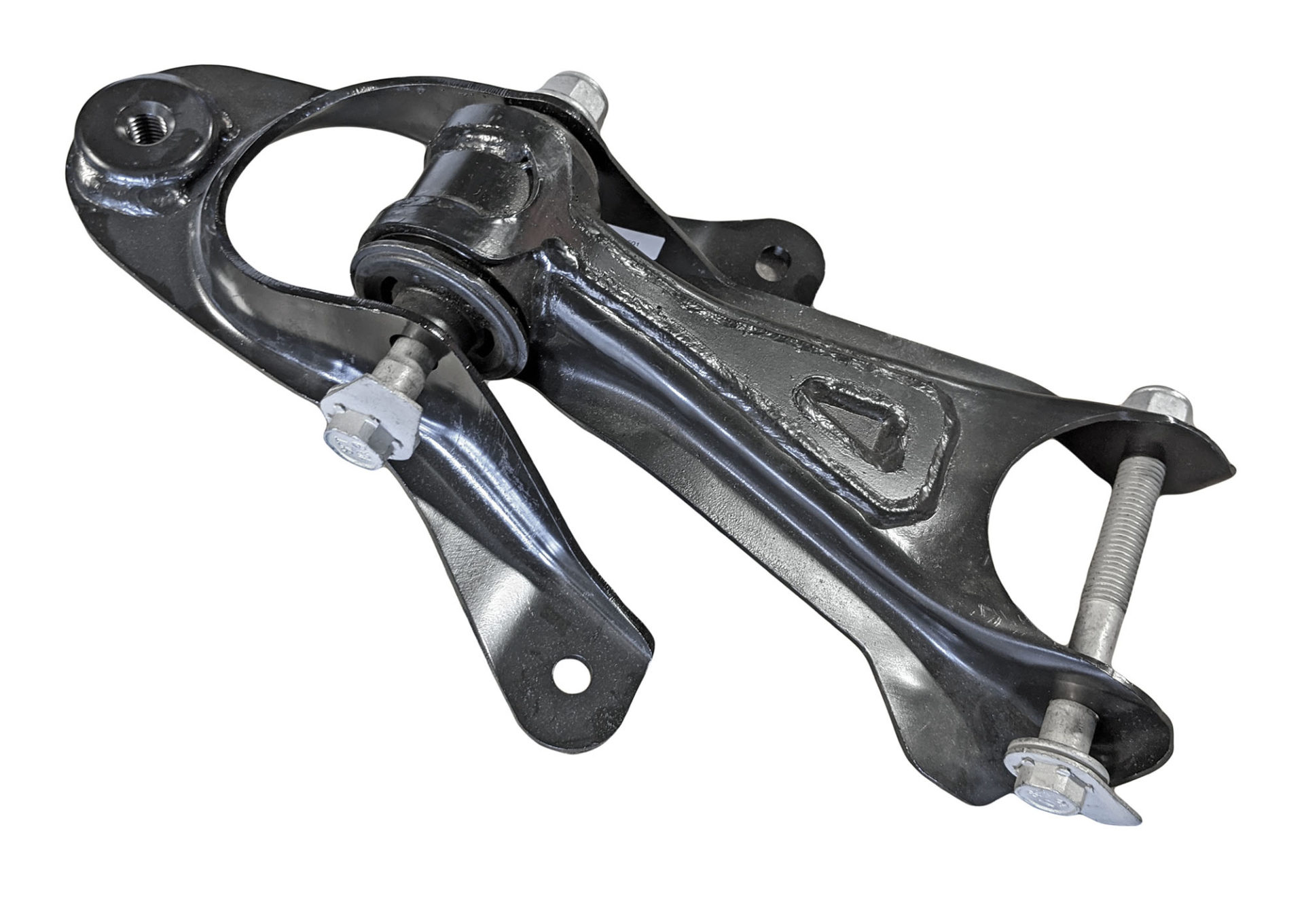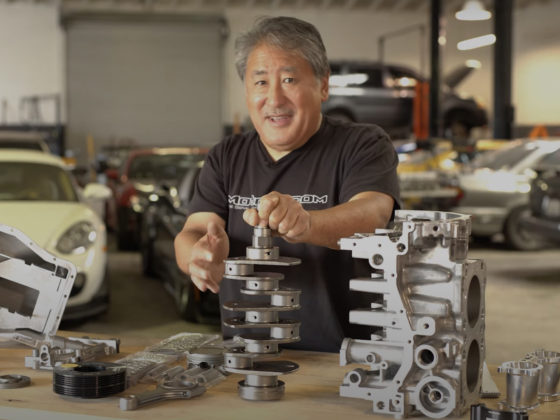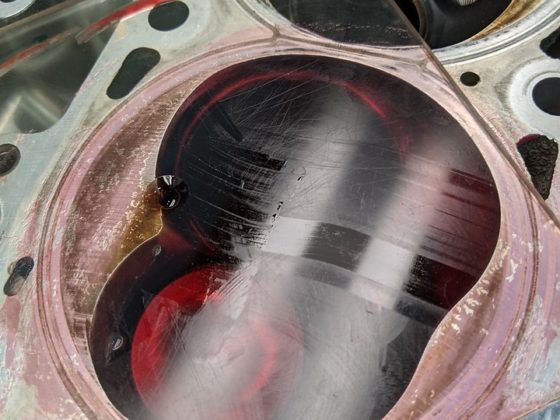 The stock 3rd link has a large diameter rubber bushing that has large voids that allow the arm to move longitudinally under load. This cushions the drivetrain shock, but contributes to wheel hop and excessive movement when accelerating out of corners on road courses.
The stock 3rd link has a large diameter rubber bushing that has large voids that allow the arm to move longitudinally under load. This cushions the drivetrain shock, but contributes to wheel hop and excessive movement when accelerating out of corners on road courses.
 By comparison, the Roush 3rd link is significantly smaller with smaller voids that allow less movement, but more than what a spherical or polyurethane bushing allows. This is the key for reducing NVH and increasing rear grip.
By comparison, the Roush 3rd link is significantly smaller with smaller voids that allow less movement, but more than what a spherical or polyurethane bushing allows. This is the key for reducing NVH and increasing rear grip.
 Reinstalling the new Roush 3rd link is the same way as removing it.
Reinstalling the new Roush 3rd link is the same way as removing it.
 An impact gun is the only real way to install the top 3rd link bolt.
An impact gun is the only real way to install the top 3rd link bolt.
 After tightening down all the bolts, the new Roush Performance 3rd link was ready to go.
After tightening down all the bolts, the new Roush Performance 3rd link was ready to go.
CONCLUSION
Overall, the 3rd link is one of the most overlooked components on the S197 Mustang. The OEM link is barely adequate for a stock car back when they were new 5-15 years ago and virtually all aftermarket options reduce rear grip and increase NVH to a level that will irritate anyone who doesn’t want a “racecar-for-the-street”.
I daily drove an S197 with a polyurethane 3rd link for over 5 years. After unsuccessfully adding a ton of Dynamat to the link itself and covering the trunk area, I finally couldn’t stand the noise and vibrations and replaced it with the Roush 3rd link, which is what I should have done in the first place.
The Roush Performance 3rd link is one of the best suspension mods you can do to your S197 Mustang. There is virtually no increase in NVH, and you’ll improve the car’s performance on the street, the strip, and on the track.
The only instances where a spherical bearing or poly 3rd link might outperform the Roush one is in a highly modified race car with a giant wing and 305-width racing slicks, where rear grip is not a problem, and even in that example, the Roush link’s increase in rear grip still might outperform the losses in it’s almost insignificant movement. But for 99.9% of the S197s out there, the Roush 3rd link is hands down the best link out there.
For those new to the platform, be sure to check out the community of track-focused Mustang enthusiasts at: TrackMustangsOnline.com
Quick Reference:
Page 1 – Problem & Roush 3rd Link
Page 2 – Remove OEM 3rd Link
Page 3 – Install Roush 3rd Link & Conclusion




19 comments
Hey Billy, nice writeup on a great upgrade. In the final picture, does that flag nut have enough reach to snug up to the 3rd link bracket (by rotating clockwise, i think) to resist loosening? Just curious.
Thanks! Yes, it wasn’t tight when I took that pic and didn’t have a good shot after it was tight. Good eye!
Honestly love live axle geometry stuff; as proven over and over it can work far better than people think.
The last photo on the second page looks like there’s a geometry change going on too, shorter link on the Roush link – or is that just the photo? Cool thing is it looks like with the design of the mount there’s a lot of tweaks that are possible to do to geometry without cutting or welding on the unibody, which I never realized was like that on the S197.
They are simple, yet effective. Yes, it’s slightly shorter but the angle makes it look like a big difference.
Back from my S197 days, I seem to remember that Ford implemented a longer 3rd link arm in the 2011-2014 cars in order to lessen the pinion angle change of the rear axle as the axle went through bump and droop…
I also remember talking to another Mustang team back than about 3rd links and they had the same to say about them: either stock or the Roush were the best options for circuit stuff really.
Interesting; not familiar with the Ford geometry specifics, is it flattening out the angle of the upper?
I know on, for example, the 1st gen RX-7 there got to be too much antisquat once you lowered the car unless you moved upper links around. And yeah agreed on simple but effective; I’m doing an SCCA GT-3 car so I’m fully onboard with live axles as a concept. 😉
The arm is shorter than the factory 2011-2014 3rd link, but the same length as the 2005-2010 3rd link. On the 2011-2014 version, the 3rd link bracket has the holes in the bracket in a different place to keep geometry in the right place for customers that may simply replace their 3rd link on their otherwise stock geometry rear suspension car.
Does the third link stop axle hop & does it change the pinion angle?
Dynamat! Oh…. the memories from my younger days… Roush beefed up the heck out of that brackets compared to the OEM design. Good stuff.
Nice writeup Billy. My S197 has a T56 Magnum XL swap with the single driveshaft, and I had to switch to an adjustable BMR 3rd link to correct the pinion angle to match the engine/trans angle. The highway speed vibration has gone away, but now I get that nice gear whine hum from running a poly bushing 3rd link which isn’t great. This Roush 3rd link looks like a great option for the reasons you described but would likely result in my pinion angle being out of alignment again. What is the best way to correct that with the Roush 3rd link? Would it be better to just adjust the lower control arms to bring the angle in, which could result in shortening the wheelbase some, or just live with the pinion angle being out?
Billy,
Great article and thank you for sharing your knowledge. The link included in the article references a 2005-2010 Roush Third Link. It looks like your build is on a 2014 S197 and I am trying to replicate this build on a 2013 S197. I’ve tried searching for a Roush Third link for a 2011-2014 S197 and I keep coming up empty. Will the 2005-2010 Third link work on a 2013 S197? If not, can you share a link on where we can find this? Thank you again.
Yes the 05-10 Roush 3rd link will work on all 05-14 cars.
Thank you very much for the quick reply.
Where can I find the roush 3rd link? Can you post a link?
A quick google search shows numerous places to buy them. Here’s the first on Google’s list:
https://www.beefcakeracing.com/401788/
Billy,
Enjoyed reading your articles. I have a 2013 Mustang 3.7 automatic. I read the article on the Roush 3rd link and want to get one installed. After some research I believe Roush made a 3rd link for the 11-14 Mustangs part #421120 which I believe has been discontinued. Just to confirm will the Roush 3rd link for 05-10 Mustangs work on my 2013 Mustang as I believe the 11-14 factory trailing arm is about an inch longer (~9.5″) than the 05-10 Mustangs factory trailing arm? My car has a 3.5″ Dynotech driveshaft with stock suspension. Will upgrade suspension down the road and probably not lower the car more than an 1-1.25″. Will the Roush 3rd link work when I lower the car or should I look at an adjustable UCA?
Yes, the 05-10 Mustang 3rd link is what I used on this 2014 car (and obviously works). As mentioned in the article, the Roush link is the best in terms of performance and NVH for everything but a track car on slicks with a lot of aero.
Hey Billy, this is a great series of articles and I’m proud to say almost all of the upgrades I’ve done to my 07 GT track car the past 4 seasons are in line with your philosophy. However, with the Roush third link there is no adjustability for pinion angle. I currently run a frpp one piece driveshaft with Steeda polyurethane adjustable third link. My research told me that adjustability is important to mitigate vibration and leaky pinion seals when running a one piece shaft. Was this a compromise in your race cars or is there a different way to adjust the Roush unit to set the correct angle?
Booooo. Roush no longer makes this piece as of today.